Research on Spatial Magnetic Field Distribution of Magnetic Fluids Based on Microstructure
Abstract
:1. Introduction
2. Models and Methods
2.1. Monte Carlo Simulation
- Initialize the position and magnetic moment of the particles in the system.
- Calculate the energy of the system in the current state E(n).
- Select a particle at random and change its position or the direction of the magnetic moment.
- Calculate the changed system energy E(n + 1) and the energy difference ΔE.
- If ΔE < 0, adopt the changed state and proceed to the next state change.
- If ΔE ≥ 0, a random number R ∈ [0, 1] is generated, and the transition probability p = exp(−ΔE/kbT) is calculated as follows:
- a.
- If R < p, adopt the new state, proceed to the next state change.
- b.
- If R ≥ p, reject the new state, proceed to the next state change.
2.2. Spatial Magnetic Field of Magnetic Fluid
2.3. Simulation Parameters
3. Results and Discussion
3.1. Influence of the Particle Size on Magnetic Fluid Structure and Magnetic Field
3.2. Influence of the Number of Particles on Magnetic Fluid Structure and Magnetic Field
3.3. Influence of the Magnetic Field Strength on Magnetic Fluid Structure and Magnetic Field
3.4. Influence of the Temperature on Magnetic Fluid Structure and Magnetic Field
4. Conclusions
Author Contributions
Funding
Institutional Review Board Statement
Informed Consent Statement
Data Availability Statement
Conflicts of Interest
References
- Akbarzadeh, A.; Samiei, M.; Davaran, S. Magnetic nanoparticles: Preparation, physical properties, and applications in biomedicine. Nanoscale Res. Lett. 2012, 7, 144. [Google Scholar] [CrossRef] [PubMed]
- Bullough, W. Electro-Rheological Fluids, Magneto-Rheological Suspensions and Associated Technology—Proceedings of the 5th International Conference; World Scientific: Singapore, 1996. [Google Scholar]
- Zheng, Q.; Li, G.; Dong, G. The preparation of Fe-Co double nanoparticle magnetic fluid by pulse laser deposition. In Proceedings of the 4th International Conference on Computer, Mechatronics, Control and Electronic Engineering, Hangzhou, China, 28–29 September 2015; pp. 446–451. [Google Scholar]
- Kaczmarek, K.; Hornowski, T.; Antal, I.; Rajnak, M.; Timko, M.; Józefczak, A. Sono-magnetic heating in tumor phantom. J. Magn. Magn. Mater. 2020, 500, 166396. [Google Scholar] [CrossRef]
- Zhao, S.; Yu, X.; Qian, Y.; Chen, W.; Shen, J. Multifunctional magnetic iron oxide nanoparticles: An advanced platform for cancer theranostics. Theranostics 2020, 10, 6278. [Google Scholar] [CrossRef] [PubMed]
- Singh, A.; Sahoo, S.K. Magnetic nanoparticles: A novel platform for cancer theranostics. Drug Discov. Today 2014, 19, 474–481. [Google Scholar] [CrossRef] [PubMed]
- Satoh, A.; Chantrell, R.W.; Coverdale, G.N.; Kamiyama, S.-i. Stokesian dynamics simulations of ferromagnetic colloidal dispersions in a simple shear flow. J. Colloid Interface Sci. 1998, 203, 233–248. [Google Scholar] [CrossRef] [PubMed]
- Promislow, J.H.; Gast, A.P. Low-energy suspension structure of a magnetorheological fluid. Phys. Rev. E 1997, 56, 642. [Google Scholar] [CrossRef]
- Peng, X.; Min, Y.; Ma, T.; Yan, M. Two-dimensional Monte Carlo simulations of a suspension comprised of magnetic and nonmagnetic particles in gradient magnetic fields. J. Magn. Magn. Mater. 2009, 321, 3250–3255. [Google Scholar] [CrossRef]
- Chikazumi, S.; Taketomi, S.; Ukita, M.; Mizukami, M.; Miyajima, H.; Setogawa, M.; Kurihara, Y. Physics of magnetic fluids. J. Magn. Magn. Mater. 1987, 65, 245–251. [Google Scholar] [CrossRef]
- Rauwerdink, A.M.; Hansen, E.W.; Weaver, J.B. Nanoparticle temperature estimation in combined ac and dc magnetic fields. Phys. Med. Biol. 2009, 54, L51. [Google Scholar] [CrossRef]
- Huang, J.; Zhong, X.; Wang, L.; Yang, L.; Mao, H. Improving the magnetic resonance imaging contrast and detection methods with engineered magnetic nanoparticles. Theranostics 2012, 2, 86. [Google Scholar] [CrossRef]
- Li, J.; Wang, B.; Liu, P. Possibility of active targeting to tumor by local hyperthermia with temperature-sensitive nanoparticles. Med. Hypotheses 2008, 71, 249–251. [Google Scholar] [CrossRef]
- Sofonea, V. Lattice Boltzmann approach to collective-particle interactions in magnetic fluids. Europhys. Lett. 1994, 25, 385. [Google Scholar] [CrossRef]
- Lak, A.; Ludwig, F.; Scholtyssek, J.M.; Dieckhoff, J.; Fiege, K.; Schilling, M. Size distribution and magnetization optimization of single-core iron oxide nanoparticles by exploiting design of experiment methodology. IEEE Trans. Magn. 2012, 49, 201–207. [Google Scholar] [CrossRef]
- Liu, W.; Zhou, M.; Kong, L. Estimation of the size distribution of magnetic nanoparticles using modified magnetization curves. Meas. Sci. Technol. 2009, 20, 125802. [Google Scholar] [CrossRef]
- Satoh, A. Introduction to Molecular-Microsimulation for Colloidal Dispersions; Elsevier: Amsterdam, The Netherlands, 2003. [Google Scholar]
- Satoh, A.; Chantrell, R.W.; Kamiyama, S.-I.; Coverdale, G.N. Two-dimensional Monte Carlo simulations to capture thick chainlike clusters of ferromagnetic particles in colloidal dispersions. J. Colloid Interface Sci. 1996, 178, 620–627. [Google Scholar] [CrossRef]
- Kristóf, T.; Szalai, I. Magnetic properties and structure of polydisperse ferrofluid models. Phys. Rev. E 2003, 68, 041109. [Google Scholar] [CrossRef] [PubMed]
- Seleznyova, K.; Strugatsky, M.; Kliava, J. Erratum: Modelling the magnetic dipole. Eur. J. Phys 2016, 37, 039601. [Google Scholar] [CrossRef]
- Hirota, N.; Ando, T.; Tanaka, R.; Wada, H.; Sakka, Y. Control of lattice spacing in a triangular lattice of feeble magnetic particles formed by induced magnetic dipole interactions. Sci. Technol. Adv. Mater. 2009, 10, 014608. [Google Scholar] [CrossRef] [PubMed]
- Aoshima, M.; Satoh, A. Two-dimensional Monte Carlo simulations of a colloidal dispersion composed of polydisperse ferromagnetic particles in an applied magnetic field. J. Colloid Interface Sci. 2005, 288, 475–488. [Google Scholar] [CrossRef]
- Goins, P.E.; Murdoch, H.A.; Hernández-Rivera, E.; Tschopp, M.A. Effect of magnetic fields on microstructure evolution. Comput. Mater. Sci. 2018, 150, 464–474. [Google Scholar] [CrossRef]
- Guo, S.L.; Yi, W.-T.; Li, Z.-Z. Effect of magnetic nanoparticles on magnetic field homogeneity. Chin. Phys. B 2023, 32, 050203. [Google Scholar] [CrossRef]
- Bornacelli, J.; Torres-Torres, C.; Arenas-Alatorre, J.; Martinez-Mondragon, M.M.; Rodriguez-Fernandez, L.; Oliver, A. Enhanced ultrafast optomagnetic effects in room-temperature ferromagnetic Pt nanoclusters embedded in silica by ion implantation. Nanotechnology 2020, 31, 355705. [Google Scholar] [CrossRef] [PubMed]
- Guo, S.; Yi, W.; Liu, W. Biological thermometer based on the temperature sensitivity of magnetic nanoparticle paraSHIFT. Nanotechnology 2021, 33, 095501. [Google Scholar] [CrossRef]
- Draack, S.; Viereck, T.; Nording, F.; Janssen, K.-J.; Schilling, M.; Ludwig, F. Determination of dominating relaxation mechanisms from temperature-dependent Magnetic Particle Spectroscopy measurements. J. Magn. Magn. Mater. 2019, 474, 570–573. [Google Scholar] [CrossRef]


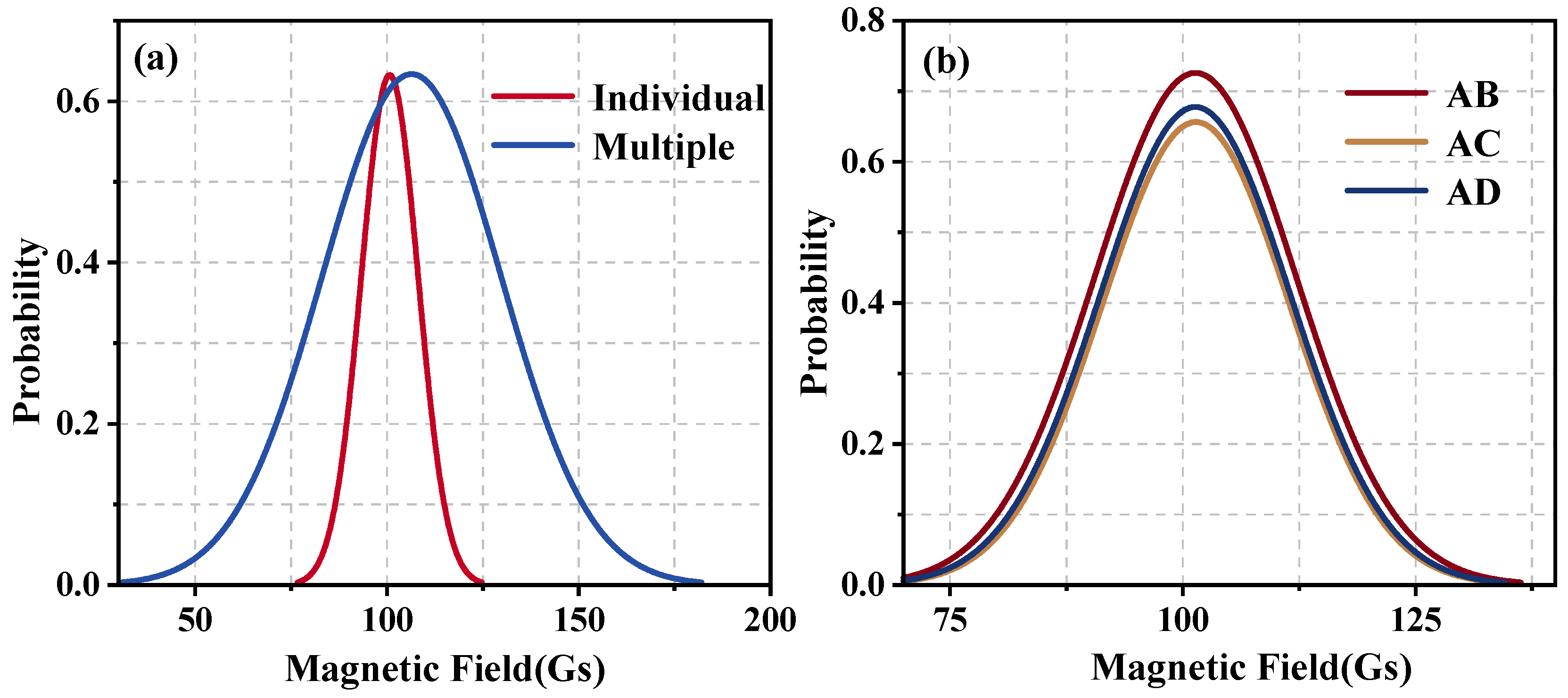

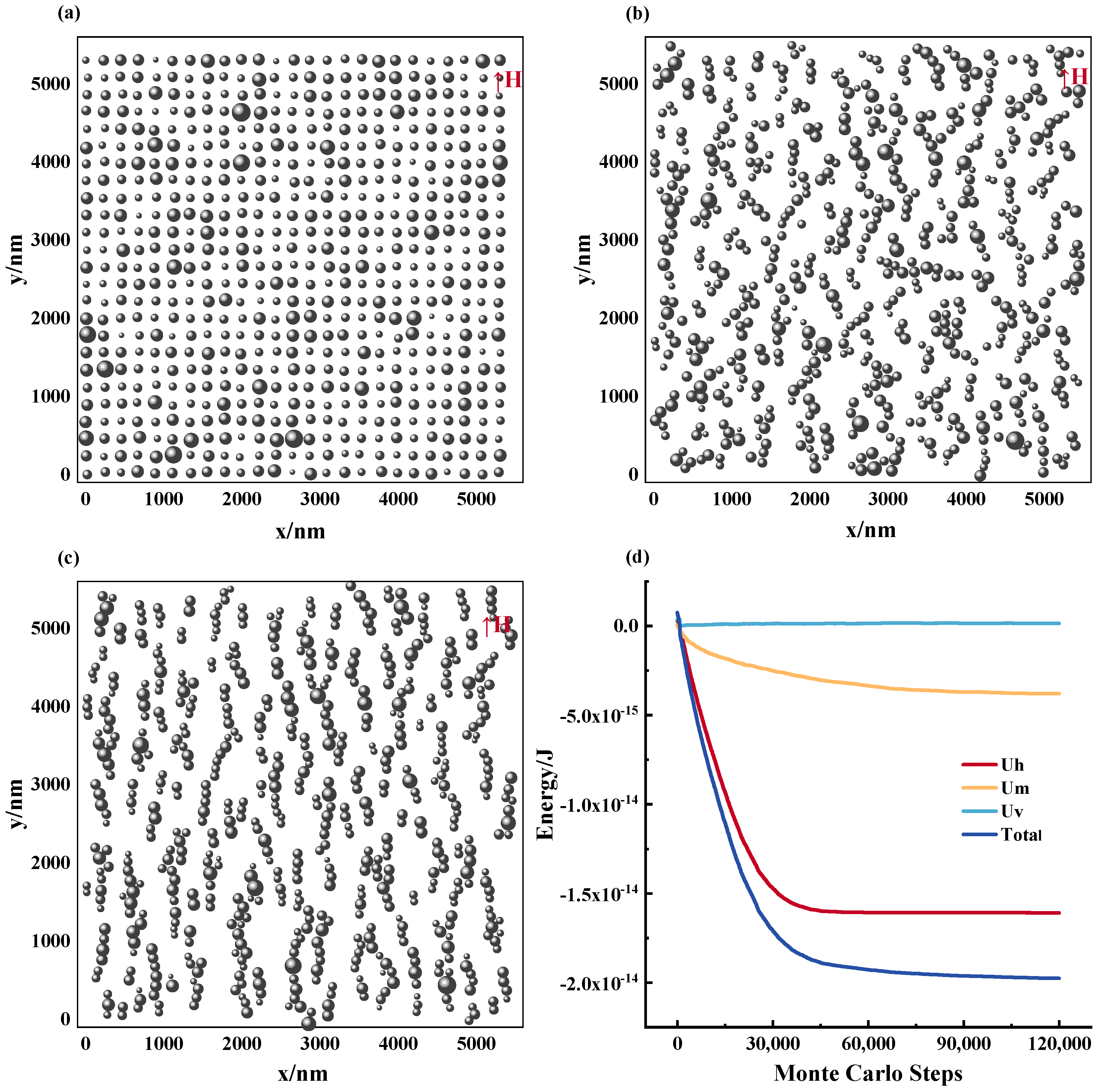



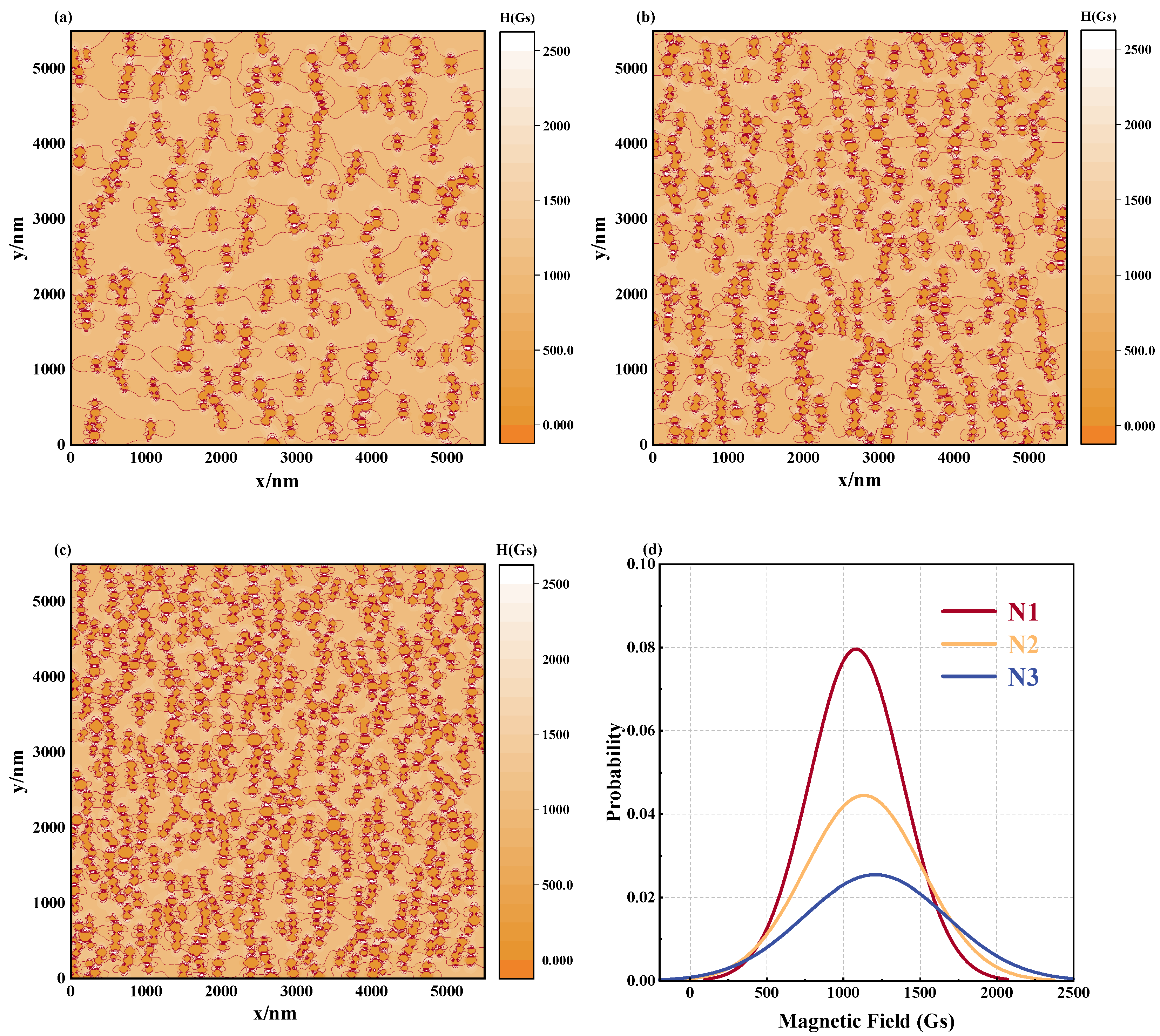
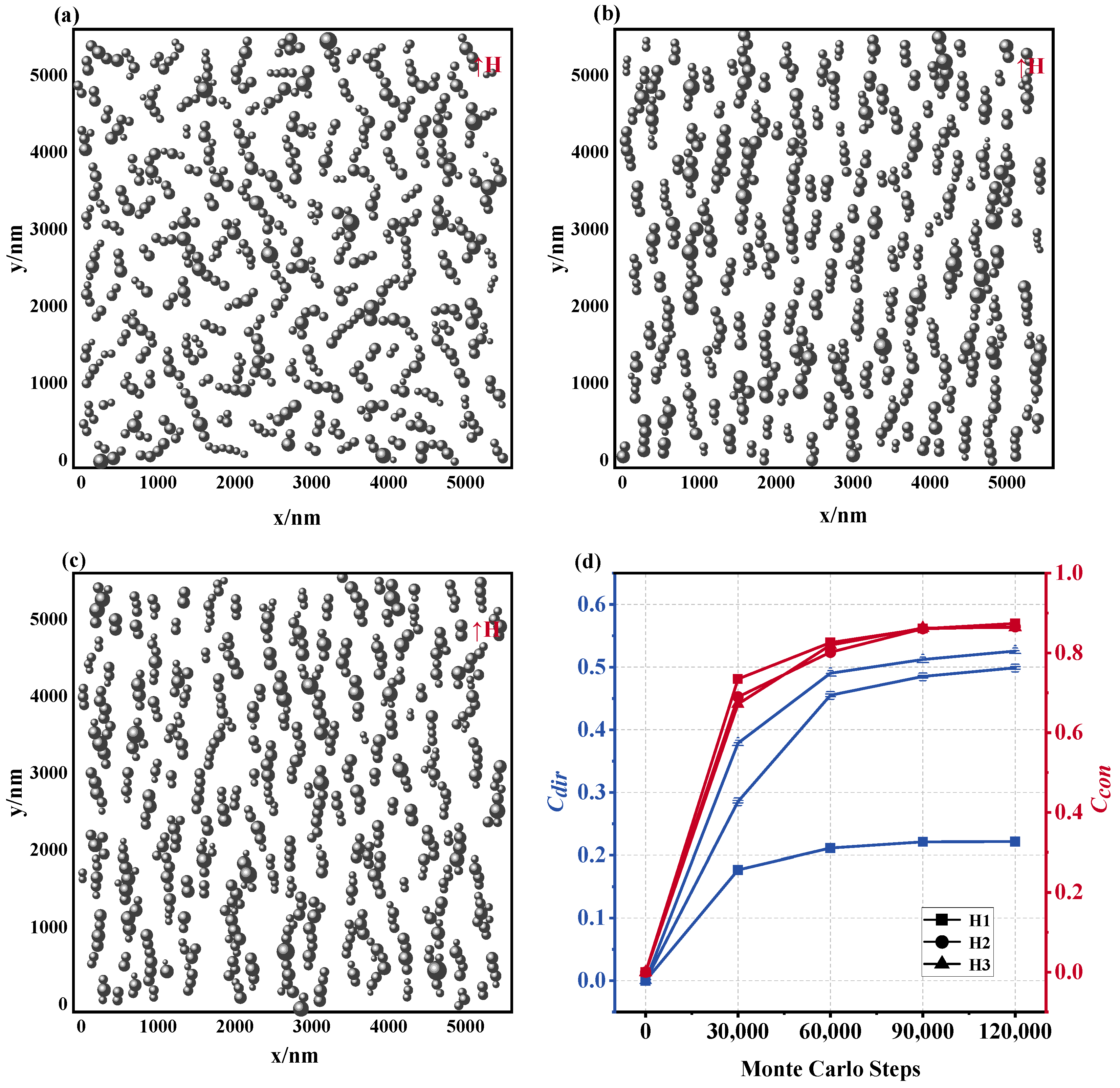


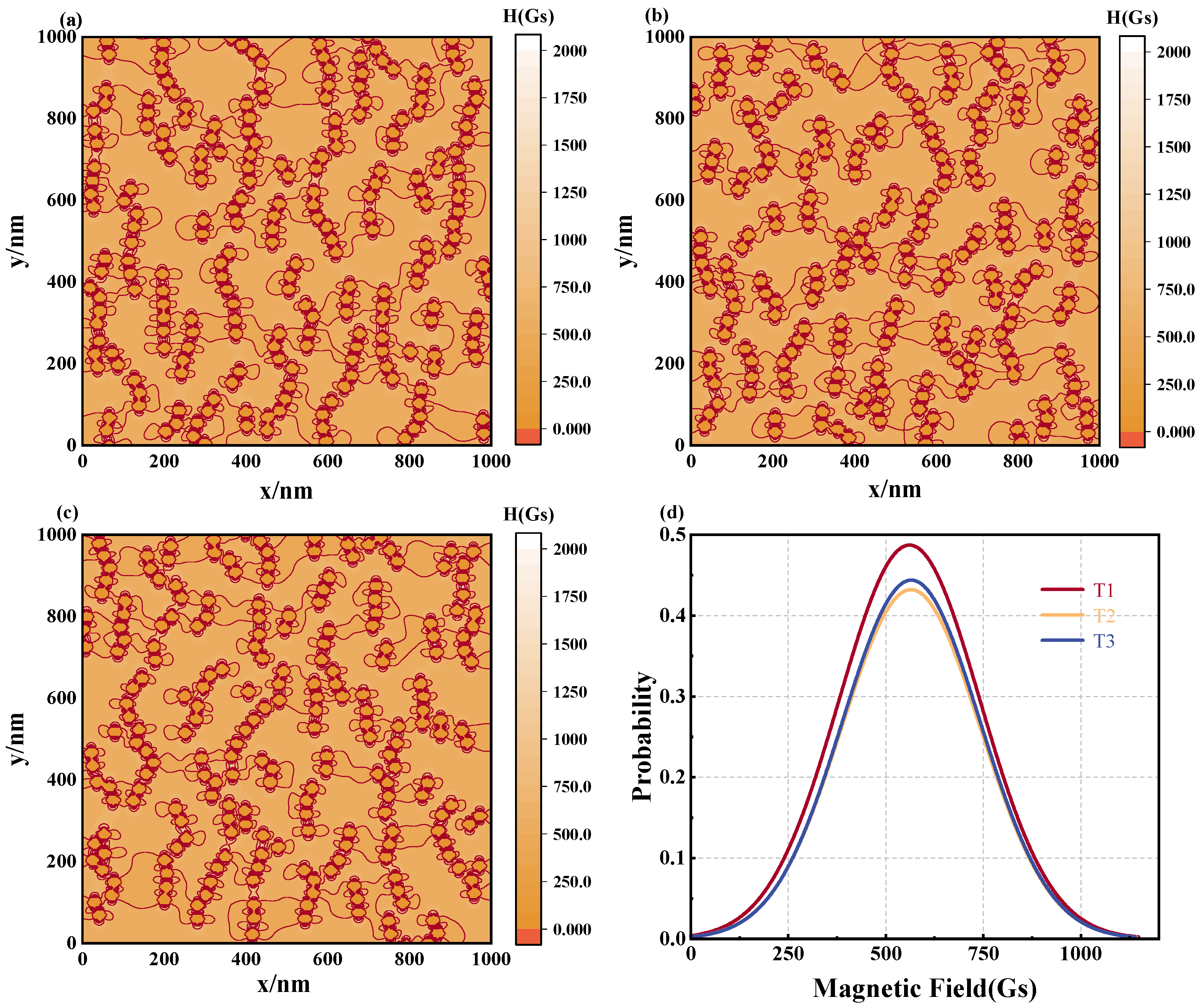
| Mean (Gs) | Standard Deviation (Gs) | Coefficient of Variation (%) | FWHM (Gs) | |
|---|---|---|---|---|
| Situation 1 | 101.358 | 10.74 | 10.596 | 25.29 |
| Situation 2 | 101.409 | 10.04 | 9.903 | 23.65 |
| Situation 3 | 101.347 | 10.22 | 10.086 | 24.07 |
| Microstructure | Magnetic Field Distribution | |||||
|---|---|---|---|---|---|---|
| d0 (nm) | Mean (Gs) | Standard Deviation (Gs) | Coefficient of Variation (%) | FWHM (Gs) | ||
| 10 | 0.21 | 0.25 | 1124.31 | 302.82 | 26.93 | 731.14 |
| 30 | 0.89 | 0.52 | 1101.11 | 334.81 | 30.41 | 784.48 |
| 100 | 0.84 | 0.49 | 1097.42 | 332.69 | 30.32 | 783.48 |
| Microstructure | Magnetic Field Distribution | |||||
|---|---|---|---|---|---|---|
| N | Ccon | Cdir | Mean (Gs) | Standard Deviation (Gs) | Coefficient of Variation (%) | FWHM (Gs) |
| 400 | 0.72 | 0.4983 | 1081.85 | 303.39 | 28.04 | 714.49 |
| 625 | 0.87 | 0.4991 | 1131.98 | 380.96 | 33.65 | 897.16 |
| 900 | 0.91 | 0.4994 | 1206.93 | 332.69 | 38.64 | 1098.16 |
| Microstructure | Magnetic Field Distribution | |||||
|---|---|---|---|---|---|---|
| H(Gs) | Mean (Gs) | Standard Deviation (Gs) | Coefficient of Variation (%) | FWHM (Gs) | ||
| 100 | 0.874 | 0.222 | 116.29 | 35.22 | 30.29 | 82.95 |
| 1000 | 0.866 | 0.499 | 1131.98 | 380.96 | 33.66 | 897.16 |
| 5000 | 0.864 | 0.526 | 5673.73 | 1983.07 | 34.95 | 4670.12 |
| Microstructure | Magnetic Field Distribution | |||||
|---|---|---|---|---|---|---|
| T (K) | Mean (Gs) | Standard Deviation (Gs) | Coefficient of Variation (%) | FWHM (Gs) | ||
| 280 | 0.863 | 0.469 | 560.48 | 180.59 | 35.57 | 425.31 |
| 300 | 0.836 | 0.452 | 564.19 | 177.31 | 31.43 | 417.55 |
| 320 | 0.831 | 0.481 | 565.05 | 176.42 | 31.22 | 415.46 |
Disclaimer/Publisher’s Note: The statements, opinions and data contained in all publications are solely those of the individual author(s) and contributor(s) and not of MDPI and/or the editor(s). MDPI and/or the editor(s) disclaim responsibility for any injury to people or property resulting from any ideas, methods, instructions or products referred to in the content. |
© 2024 by the authors. Licensee MDPI, Basel, Switzerland. This article is an open access article distributed under the terms and conditions of the Creative Commons Attribution (CC BY) license (https://creativecommons.org/licenses/by/4.0/).
Share and Cite
Zhang, B.; Zhang, Y. Research on Spatial Magnetic Field Distribution of Magnetic Fluids Based on Microstructure. Materials 2024, 17, 2994. https://doi.org/10.3390/ma17122994
Zhang B, Zhang Y. Research on Spatial Magnetic Field Distribution of Magnetic Fluids Based on Microstructure. Materials. 2024; 17(12):2994. https://doi.org/10.3390/ma17122994
Chicago/Turabian StyleZhang, Bin, and Yapeng Zhang. 2024. "Research on Spatial Magnetic Field Distribution of Magnetic Fluids Based on Microstructure" Materials 17, no. 12: 2994. https://doi.org/10.3390/ma17122994




